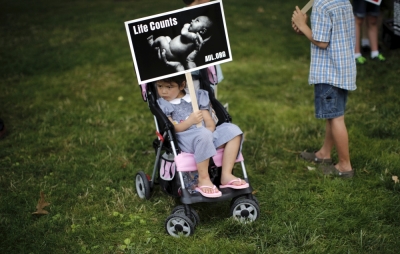Kirsten Powers misinforms on abortion issue

A couple of weeks ago, pro-lifers were elated when Georgia Governor Brian Kemp signed Georgia’s heartbeat legislation into law. This law legally protects unborn children after a fetal heartbeat can be detected – usually around six weeks’ gestation. As such, Georgia became the fourth state, along with Ohio, Mississippi, and Kentucky to enact such a law. The passage of this bill, along with the recent pro-life legislation in Alabama that would ban most abortions, has significantly raised the salience of sanctity of life issues in recent weeks. Unfortunately, much of the subsequent commentary and analysis from the mainstream media has generated far more heat than light.
However, the most disappointing commentary of the past week came from Kirsten Powers whose editorial appeared in USA Today on Tuesday May 14th. Many pro-lifers have appreciated Powers’ previous op-eds. Her April 2013 editorial chastising the mainstream media for their unwillingness to cover the trial of notorious late term abortionist Kermit Gosnell generated a great deal of debate and discussion. It also appeared to increase the number of reporters covering both Gosnell’s misconduct and the trial itself. Additionally, in June of 2015, Powers wrote an editorial for USA Today criticizing Planned Parenthood after undercover videos revealed abortion doctors discussing the harvesting of aborted body parts for medical research.
That said, Powers recent USA Today column about the Georgia heartbeat bill reads like a Planned Parenthood press release. In her editorial where she expresses opposition toward the legislation, she rehashes the tired trope that pro-lifers only pay “lip service to caring for women.” Unsurprisingly, she makes no mention of the 3,000 pregnancy help centers, funded by pro-lifers, that are assisting countless women with unplanned pregnancies every day. She cavalierly dismisses overturning Roe v. Wade as a strategy to reduce abortion. Instead, Powers claims that universal health care and Medicaid expansion are proven strategies for lowering abortion rates – but fails to provide any empirical evidence to support this claim.
Even worse, Powers doubled down on Twitter. She took issue with a tweet by Live Action which argued that heartbeat bills enjoy popular support. However, public opinion on abortion is nuanced, and it is unsurprising that Powers could find a differently worded poll question that showed less public support for this type of legislation. Powers then downplayed abortion regret citing the UCSF/Bixby Turnaway Study which purportedly found that 95 percent of post-abortive women felt that abortion was the right decision after 5 years. However, that study was conducted by researchers who favor legal abortion. Furthermore, approximately 62 percent of women declined to participate in the study, and of those that did – only about half completed all the follow-up interviews.
Powers was her worst. She claimed that, “If you want fewer abortions then you should support policies that help women who don’t have the resources to support a pregnancy or childbirth or another child.” First, it should be noted that pro-lifers have always generously supported pregnancy help centers, which provide material assistance, health care, and counseling for women facing unplanned pregnancies. More importantly, Powers provides absolutely no evidence that more generous welfare or health care programs will do anything to reduce the abortion rate.
In fact, Powers can learn an important lesson from pro-lifers because the pro-life movement has actually enjoyed success in reducing the incidence of abortion. Between 1980 and 2015 – the most recent years for which we have data – the U.S. abortion rate fell by 50.17 percent. The main reason for this decline is because a higher percentage of unintended pregnancies are being carried to term. This shows that pro-life efforts to change hearts and minds, enact protective laws, and take care of the material needs of pregnant women have all been successful. Furthermore, since welfare policy became more conservative during the 1980s and 1990s, it is very hard to argue that more generous welfare programs had anything to do with this durable, long-term decline in the incidence of abortion.
As a columnist for USA Today, Powers has the potential to do a great deal of good for the pro-life movement. The mainstream media rarely features commentary with a pro-life perspective, and Powers’ previous columns on both the Kermit Gosnell trial and Planned Parenthood misconduct usefully informed the public debate on sanctity of life issues. That said, her newfound opposition toward protective pro-life legislation is disappointing. Furthermore, her advocacy for more generous social programs as a strategy for reducing abortion rates is not supported by any credible research. Even worse, Powers is failing to use her influence to encourage pro-lifers to support strategies – including protective legislation, educational programs, and pregnancy help centers – which have a proven track record of reducing abortion rates.
Originally posted at cnsnews.com




























